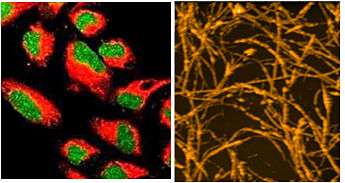Research program in the Verma group applies bioessential molecules for creating organic frameworks, to study biomimetic processes and to decipher ordered aggregation relevant to certain neurodegenerative diseases. These studies encompass a broad canvass of synthetic organic chemistry, crystallog-raphy, microscopy, and cell and material studies.
Our ongoing work on metal-nucleobase interaction focuses on existing knowledge of nucleic acid-metal interactions to craft structurally interesting architectures with outstanding photophysical properties, new materials for gas storage and hybrid electrodes. We have reported formation of entangled networks and extended frameworks, with selective and reversible water vapour and gas adsorption behavior. On another note, a green fluorescent gold nanocluster, stabilized by modified purine ligand, was reported as a stable, nuclear stain for a variety of cancer cells.
Peptide-based self-assembly offers unique entry to construction of soft structures, in order to model molecular mechanisms of aggregation-induced diseases and for designing soft materials with desired properties and functions. It is proposed that precise control over shape and size selectivity in peptide-based nanostructures also offers crucial insight into operating mechanisms associated with protein self-assembly process.
We work on peptide conjugates to address prion protein and Ab aggrega-tion. In this context, we also design small molecules which interfere with protein/peptide aggregation. One such example is inhibition of insulin amyloidogenesis by designed peptide conjugates. Our laboratory is engaged in rational ligand synthesis and inhibition of amyloidogenic diseases.

 New Office Automation (Pingala)
New Office Automation (Pingala) 






